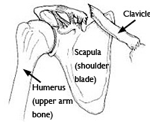Operative Treatment for Clavicle Fractures (Broken Collarbone)
Clavicle fractures are often caused by a direct blow to the shoulder. In sports, it usually occurs when an athlete is tackled in a football game, falls of a bicycle, or gets body-checked into the plexi-glass of an ice rink. It can also happen during a fall onto the shoulder or a car collision, a fall onto an outstretched arm, or in childbirth, when the baby is passing through the birth canal.
The clavicle is a long bone and most breaks occur in the middle of it. Occasionally, the bone will break where it attaches at the ribcage or shoulder blade.

Symptoms
Clavicle fractures can be very painful and may make it hard to move your arm.
Additional symptoms include:
- Sagging shoulder (down and forward)
- Inability to lift the arm because of pain
- A grinding sensation if an attempt is made to raise the arm
- A deformity or “bump” over the break
- Bruising, swelling, and/or tenderness over the collarbone
Evaluation by an OSS physician
In order to pinpoint the location and severity of the break, your OSS physician will order an x-ray. X-rays of the entire shoulder will often be done to check for additional injuries. If other bones are broken, your doctor may order a computed tomography (CT or CAT) scan to see the fractures in better detail.
If your bones are out of place (displaced), your OSS physician may recommend surgery. Surgery can align the bones exactly and hold them in good position while they heal. This can improve shoulder strength when you have recovered, if displacement is significant. A recent large study showed improvement in function with operative repair when the fracture is significantly displaced.
The use of Plates and Screws
During this operation, the bone fragments are first repositioned into their normal alignment, and then held in place with special screws and/or by attaching metal plates to the outer surface of the bone. Newer locking plates are contoured to give significant strength while minimizing the prominence of the plate. Many patients notice immediate improvement in the disturbing bone movement right after surgery.
After surgery, you may notice a small patch of numb skin below the incision. This numbness will become less noticeable with time. Because there is not a lot of fat over the collarbone, you may be able to feel the plate through your skin. It is important to start full range of motion soon after surgery.
Plates and screws are sometimes removed after the bone has healed, but that is up to the patient’s discretion. This is a much smaller procedure with little down time, usually 4-6 months after the original surgery.

(A) The clavicle is broken in more than one place and the fragments are severely out of alignment. (B)The fractured pieces are held in place by a combination of plates and screws.
Rehabilitation
Specific exercises will help restore movement and strengthen your shoulder. Your OSS physician may provide you with a home therapy plan or suggest that you work with a physical therapist.
Therapy programs typically start with gentle motion exercises. Your OSS physician will gradually add strengthening exercises to your program as your fracture heals.
Although it is a slow process, following your physical therapy plan is an important factor in returning to all the activities you enjoy.
Surgical Complications
People who use nicotine, have diabetes, or are elderly are at a higher risk for complications during and after surgery. They are also more likely to have problems with wound and bone healing. Be sure to talk with your OSS physician about the risks and benefits of surgery for your clavicle fracture.
There are risks associated with any surgery, including:
- Infection
- Bleeding
- Pain
- Blood clots in your leg
- Damage to blood vessels or nerves
- Nausea
The risks specific to surgery for collarbone fractures include:
- Difficulty with bone healing
- Injury to surrounding vessels/organs (rare)
- Hardware irritation
Outcome
Whether your treatment involves surgery or non-surgical treatment, it can take several months for your collarbone to heal. It may take longer in diabetics or people who nicotine.
Most people return to regular activities within 3 months of their injury. Your OSS physician will tell you when your injury is stable enough to do so. Returning to regular activities or lifting with your arm before your doctor advises may cause your fracture fragments to move or your hardware to break. This may require you to start your treatment from the beginning.
Once your fracture has completely healed, you can safely return to sports and daily activities.
What to discuss with your OSS Surgeon
- When will I be able to start using my arm?
- When can I return to work?
- Do I have any specific risks for not doing well?
- If I have surgery, what are the risks and benefits and how long will I be in the hospital?
- If I do not have surgery what are the risks and benefits?
- Is my bone weak?
- Should I be taking calcium and Vitamin D?
If you would like more information about clavicle surgery, call Orthopedic Specialists of Seattle (206) 633-8100 to schedule an appointment with an OSS surgeon.
